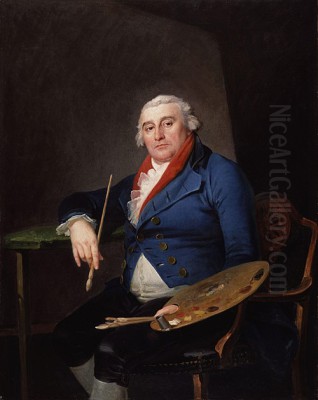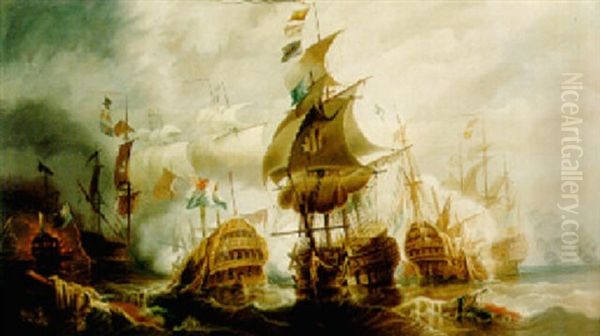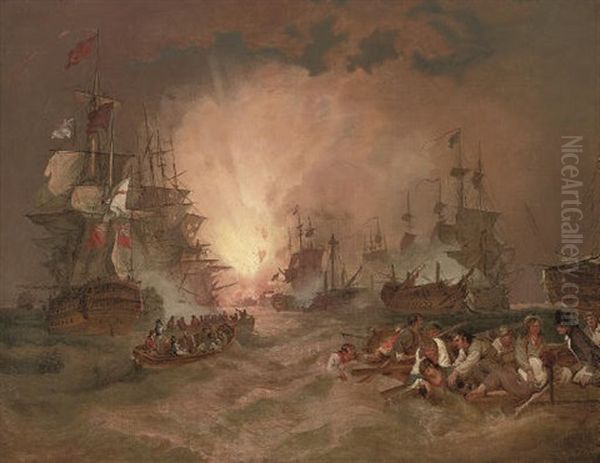
Philip James de Loutherbourg (born Philippe-Jacques de Loutherbourg) stands as a fascinating and multifaceted figure in the landscape of late 18th and early 19th-century European art. Born in Strasbourg on October 31, 1740, and passing away in Chiswick, London, on March 11, 1812, his career bridged the artistic worlds of France and Britain. He was not merely a painter but also a highly innovative stage designer, printmaker, and the inventor of a unique form of mechanical theatre. His work captured the burgeoning spirit of Romanticism, explored the dramatic potential of landscapes and historical events, and left an indelible mark on both the fine arts and the evolution of theatrical spectacle.
Early Life and Artistic Formation in France
Loutherbourg's artistic inclinations were nurtured from a young age. His father, Philip James Loutherbourg the Elder, was a miniaturist painter of Polish origin who had worked at the court of Darmstadt. Under his father's initial guidance, the young Loutherbourg received a broad education in Strasbourg, encompassing languages and mathematics alongside art. However, his prodigious talent soon demanded more formal training. Destined initially by his father for the Lutheran ministry, his passion for art ultimately prevailed.
Around 1755, the family moved to Paris, a vibrant centre of European art. There, Loutherbourg entered the studio of Charles-André van Loo, a prominent history painter and a key figure in the French Rococo style. He further honed his skills, particularly in landscape and battle scenes, under the tutelage of Francesco Casanova, brother of the famous adventurer Giacomo Casanova and himself a respected painter known for his dynamic depictions of cavalry skirmishes and pastoral landscapes. Some accounts also mention Jean-Baptiste Tischebein as an early influence or teacher.

Loutherbourg quickly gained recognition in the competitive Parisian art scene. His paintings, often featuring pastoral scenes, shipwrecks, or battles, were admired for their technical skill, lively compositions, and atmospheric effects. In 1767, at the remarkably young age of 27, he was elected to the prestigious French Académie Royale de Peinture et de Sculpture, even though he was technically below the required age. This honour cemented his reputation as one of France's most promising young artists. His early works showed an affinity for the picturesque and the dramatic potential of nature, hinting at the Romantic sensibilities that would fully blossom later in his career.
Relocation to London and Theatrical Revolution
Despite his success in France, Loutherbourg made a pivotal decision in 1771 to relocate to London. The reasons for this move are debated but likely involved seeking new opportunities and perhaps a different artistic environment. London was a burgeoning metropolis with a dynamic theatre scene, offering fertile ground for his diverse talents. His arrival coincided with a period of significant development in British art and theatre.
Almost immediately upon arriving, Loutherbourg secured a position that would profoundly shape his career and influence British stagecraft. He was engaged by the legendary actor-manager David Garrick as the chief scene designer for the Theatre Royal, Drury Lane, London's premier playhouse. Garrick, known for his own reforms towards greater naturalism in acting, recognized Loutherbourg's potential to revolutionize the visual aspects of theatre production.
At Drury Lane, Loutherbourg commanded an impressive salary and was given considerable creative freedom. He moved away from the symmetrical, static backdrops common at the time, introducing instead more dynamic, asymmetrical designs that aimed for greater realism and atmospheric depth. He experimented extensively with lighting, using coloured silks and transparencies placed before light sources (predominantly Argand lamps) to simulate different times of day, weather conditions, and moods – effects previously unseen on the London stage. He also incorporated sophisticated mechanical devices to create illusions of movement and transformation.
His designs for productions like the pantomime A Christmas Tale (1773) and the spectacular Omai, or, a Trip round the World (1785) were lauded for their ingenuity and visual splendour. He brought his painter's eye to the stage, creating immersive environments that enhanced the dramatic narrative. His work significantly raised the standard and ambition of scenic design in Britain, influencing generations of theatre practitioners and contributing to the growing taste for spectacle and visual realism in performance. His collaboration with Garrick marked a high point in the integration of visual art and theatrical performance.
The Eidophusikon: A Mechanical Marvel

Perhaps Loutherbourg's most famous and unique contribution was the Eidophusikon, translating roughly as "image of nature." Unveiled in a small auditorium at his home in Lisle Street, Leicester Square, in 1781, the Eidophusikon was a miniature mechanical theatre that used sophisticated techniques to create moving pictures depicting natural phenomena and dramatic scenes. It represented a remarkable fusion of painting, mechanics, and lighting effects, prefiguring aspects of later cinematic technology.
The Eidophusikon stage was relatively small, perhaps six feet wide and eight feet deep, but through clever manipulation of perspective, light, and sound, Loutherbourg created illusions of vast scale and dramatic action. He used layers of painted transparencies, cut-out figures, coloured glass, and strategically placed lamps to simulate sunrise, sunset, moonlight, storms at sea, volcanic eruptions, and even mythological scenes like Satan arraying his troops by the fiery lake from Milton's Paradise Lost. Sound effects, produced by assistants using devices like rain boxes and thunder sheets, enhanced the realism.
The Eidophusikon was an immediate sensation, attracting fashionable audiences who marvelled at its lifelike representations. Fellow artists were particularly impressed; Thomas Gainsborough, a leading portraitist and landscape painter of the era, was reportedly captivated by the device, attending performances repeatedly. It demonstrated Loutherbourg's profound understanding of light and atmosphere and his ability to translate the principles of landscape painting into a dynamic, time-based medium.
Despite its initial success and artistic significance, the Eidophusikon was not a lasting financial venture. Its intricate mechanisms and the cost of maintaining the effects proved prohibitive. After a few seasons and attempts to tour the device, it eventually faded from public view. However, its legacy endured. The Eidophusikon stands as a crucial precursor to later forms of visual entertainment like the Panorama and Daguerre's Diorama, and ultimately, it foreshadowed the development of motion pictures, demonstrating the public appetite for immersive, illusionistic visual experiences. The connection noted by some sources to Thomas Edison's phonograph might be more conceptual (as an inspiration for recorded experiences) rather than direct technical influence.
Painting: Landscapes and the Sublime
While deeply involved in theatrical work, Loutherbourg continued to pursue his career as a painter. His move to Britain exposed him to the developing British landscape tradition, exemplified by artists like Richard Wilson, often called the "father of British landscape painting." Loutherbourg, however, brought his own continental training and theatrical flair to the genre, becoming a key figure in the transition towards Romanticism.

He was particularly drawn to the wilder, more dramatic aspects of nature, embodying the aesthetic concept of the Sublime, as articulated by philosopher Edmund Burke. Burke's theory emphasized feelings of awe, terror, and overwhelming power evoked by vast, rugged, or dangerous natural scenes. Loutherbourg excelled at capturing these sensations in his paintings of storms, shipwrecks, mountain scenery, and dramatic weather effects. He undertook sketching tours through scenic areas of Britain, including Wales, the Peak District, and the Lake District, gathering material for his dramatic compositions.
His famous painting An Avalanche in the Alps (1803, Tate Britain) is a quintessential example of his engagement with the Sublime. It depicts the terrifying power of nature unleashed, using dynamic composition, stark contrasts of light and shadow (chiaroscuro), and vigorous brushwork to convey the scene's energy and danger. Human figures are dwarfed by the immense scale of the landscape, emphasizing nature's dominance.
Loutherbourg also responded to the changing landscape of Britain during the early Industrial Revolution. His painting Coalbrookdale by Night (1801, Science Museum, London), though sometimes debated in attribution, is a powerful image of industrial activity set against a nocturnal landscape, the furnaces casting an infernal glow. Similarly, works depicting scenes like the ironworks in Wales (Swansea: Two Kilns and Other Buildings) show his interest in these new, man-altered environments, often imbued with a sense of awe and dramatic power akin to his natural landscapes. His work influenced younger Romantic painters like J.M.W. Turner, who admired his dramatic effects, and perhaps John Constable, though Constable pursued a more naturalistic path.
Maritime and Historical Paintings
Loutherbourg made significant contributions to maritime painting, particularly depictions of naval battles, a genre that gained popularity in Britain during an era of frequent warfare and burgeoning national pride. His theatrical background equipped him well to handle the complex compositions, dramatic action, and atmospheric effects required for these large-scale canvases.
His most celebrated work in this genre is The Defeat of the Spanish Armada (1796, National Maritime Museum, Greenwich). Commissioned as part of a series celebrating British naval history, this large, panoramic painting captures the chaos and drama of the 1588 battle with swirling smoke, turbulent seas, and numerous ships engaged in combat. While perhaps not strictly accurate in every historical detail, it powerfully conveys the national narrative of heroic defence against overwhelming odds.
He also painted contemporary naval victories, capitalizing on patriotic fervour. Works like Lord Howe's action, or the Glorious First of June (1795, National Maritime Museum) and The Battle of Camperdown (1799, Tate Britain) depict recent triumphs against the French and Dutch fleets during the Revolutionary Wars. The Battle of the Nile (1800, Tate Britain) similarly commemorated Nelson's victory. These paintings were often translated into popular prints, disseminating images of British naval power to a wide audience. Loutherbourg's approach combined reportage with high drama, influencing other marine painters like Nicholas Pocock, who also specialized in documenting naval engagements, though Loutherbourg's style remained distinctively more theatrical compared to the more topographical approach of predecessors like Charles Brooking or Samuel Scott, or the Dutch masters like Willem van de Velde the Younger who had heavily influenced the British tradition.
Beyond naval scenes, Loutherbourg tackled other historical and literary subjects. His dramatic compositions often drew inspiration from literature, such as the aforementioned Eidophusikon scene based on Milton's Paradise Lost. He also produced illustrations, including work for Macklin's Bible and Thomas Macklin's edition of The Arabian Nights, collaborating with other artists and engravers like Christian von Mechel on print series. His painting The Vision of the White Horse (1798), depicting an apocalyptic scene from the Book of Revelation, showcases his interest in dramatic religious themes, aligning him with other artists exploring the Sublime and the supernatural, such as James Barry or later, John Martin.
Mysticism and Later Life
Loutherbourg's life took an unusual turn in the late 1780s. Around 1789, influenced perhaps by the millenarian atmosphere of the time and his own inclinations towards the dramatic and mysterious, he became involved with the notorious adventurer and occultist Alessandro Cagliostro. For a brief period, Loutherbourg and his wife, Lucy, became practitioners of faith healing, attracting crowds to their home in Hammersmith seeking cures.
This foray into mysticism and healing proved short-lived and controversial. Public opinion turned against them, culminating in an incident where an angry mob attacked their house. Following this, Loutherbourg largely abandoned these activities and returned his focus to painting. This episode, however, adds another layer to his complex personality, revealing an interest in the spiritual, the esoteric, and the power of belief, themes that perhaps subtly informed the dramatic intensity of his artistic output. His wife Lucy, who managed his affairs, was reportedly keen to control his public image during and after this period.
In his later years, Loutherbourg continued to paint and exhibit, primarily landscapes and coastal scenes. He was elected a full member of the Royal Academy in London in 1781, having been an Associate since 1780. He settled in Chiswick, where he enjoyed a degree of prosperity and continued respect within the art world, despite the earlier controversy. He died there in 1812 and was buried at Chiswick Old Cemetery.
Artistic Style and Techniques
Loutherbourg's artistic style is characterized by its dynamism, theatricality, and embrace of Romantic sensibilities. He moved beyond the calmer, more ordered landscapes of the earlier 18th century, infusing his scenes with energy, strong emotion, and often a sense of drama or impending doom. His compositions are frequently complex and asymmetrical, employing diagonal lines and contrasting forms to create visual excitement.
His mastery of light and shadow, or chiaroscuro, was central to his style. Learned partly from his French training and honed through his experiments with stage lighting, he used dramatic contrasts to model forms, create depth, and enhance the emotional atmosphere of his paintings. Whether depicting the fiery glow of a furnace, the ethereal light of the moon, or the gloom of an approaching storm, his handling of light was always purposeful and effective.
His colour palette could range from relatively subdued tones in pastoral scenes to vibrant, almost lurid hues in his depictions of battles, fires, or supernatural events. His brushwork was often vigorous and expressive, contributing to the overall energy of his work, although he was also capable of fine detail when required.
Technically, Loutherbourg was versatile, proficient in oil painting, watercolour, and various printmaking techniques, particularly etching and aquatint, which allowed for tonal effects well-suited to his atmospheric style. His experience across different media – painting, printmaking, and stage design – mutually informed his practice, giving his work a unique cross-disciplinary richness.
Influence and Legacy
Philip James de Loutherbourg's influence was felt across several fields. In painting, he was a crucial figure in the development of British Romantic landscape painting. His dramatic interpretations of nature and his focus on the Sublime paved the way for artists like J.M.W. Turner, who explicitly acknowledged his debt to Loutherbourg's atmospheric effects and dynamic compositions. While John Constable took a different path towards naturalism, Loutherbourg's success helped elevate the status of landscape painting in Britain. His dramatic historical and biblical scenes also resonated with artists like John Martin.
In the theatre, his innovations in scenic design and lighting at Drury Lane set new standards for visual spectacle and atmospheric realism. He demonstrated how the visual elements of a production could actively contribute to the storytelling and emotional impact, moving beyond mere decoration. His work influenced subsequent generations of stage designers in Britain and beyond.
The Eidophusikon, though ephemeral, was a landmark in the history of visual entertainment. It demonstrated the potential for creating immersive, moving illusions through the manipulation of light, mechanics, and sound, anticipating technologies and artistic forms that would emerge much later. It represents a key moment in the pre-history of cinema and multimedia performance.
Loutherbourg's career also highlights the fruitful cross-fertilization between French and British art scenes in the 18th century. He brought elements of his French training – technical facility, compositional boldness – to Britain, while also absorbing and contributing to the developing traditions of British landscape and maritime painting. His works are held in major collections worldwide, including Tate Britain, the National Maritime Museum, the Victoria and Albert Museum, the British Museum, the Louvre, and many others, attesting to his enduring significance.
Conclusion
Philip James de Loutherbourg was far more than just a painter. He was an innovator, a showman, and a visionary whose talents spanned the fine arts and theatrical production. From the battlefields of Casanova's studio to the stages of Garrick's Drury Lane, and from the dramatic landscapes of Britain to the miniature marvels of the Eidophusikon, his career was marked by a restless energy and a constant striving for dramatic effect. He captured the spirit of a changing age, reflecting the awe inspired by both the power of nature and the dawn of industry. As a pioneer of Romanticism in painting and a revolutionary force in stage design, Loutherbourg left a rich and varied legacy that continues to fascinate and inspire.